By Pauline Webber
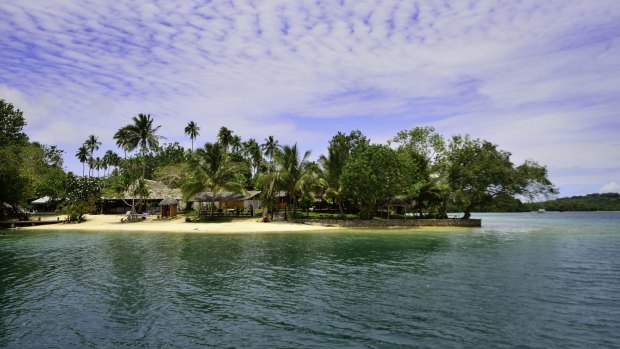
Oyster Island Resort sits in a spectacular marine reserve off Espiritu Santo, north-west of Vila.Credit: M. Gebicki
On Port Vila's main thoroughfare, shops are open, cafes are busy, and the vast waterfront produce market once again has its quota of colourfully dressed "mamas" selling fruit, vegetables and handicrafts.
It's a huge contrast to the images of destruction beamed around the world after Tropical Cyclone Pam ripped through this town and many of Vanuatu's other islands on March 13, knocking out communications to the small Pacific island nation for days.
While the immediate emergency is over, there's one industry whose recovery depends on the world replacing those vivid scenes of destruction with images of palm trees and pina coladas: tourism. This vital industry provides more than 40 per cent of the national income and its viability is crucial to Vanuatu's future.
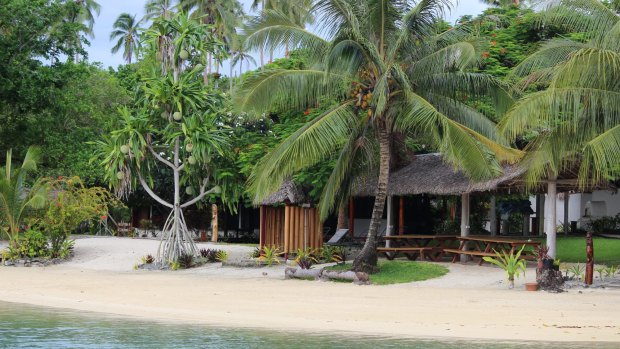
Oyster Island Resort has a relaxed feel.
Vanuatu's 82 islands are strung out over 12,274 kilometres of ocean. Cyclone Pam battered Efate, where Port Vila, the nation's capital, and its only substantial town, is located.
Tanna copped a beating, while Pentecost, famous for its annual land-diving festival, escaped fairly lightly. And Pam completely bypassed the country's second-biggest tourist sector and largest island, Espiritu Santo. But these fine distinctions mean little to outsiders, so Santo's hoteliers have just had to cop the cancellations like everyone else, while trying to get the message out that it's business as usual in their bit of paradise.
Many of the big resorts and almost all the smaller boutique properties have re-opened or soon will. And, if you're the sort of traveller who hankers after more than bungalows and beach bars, Vanuatu still has in abundance something that has been lost from many more developed tourist destinations: an easy and immediate connection with the nation's people.
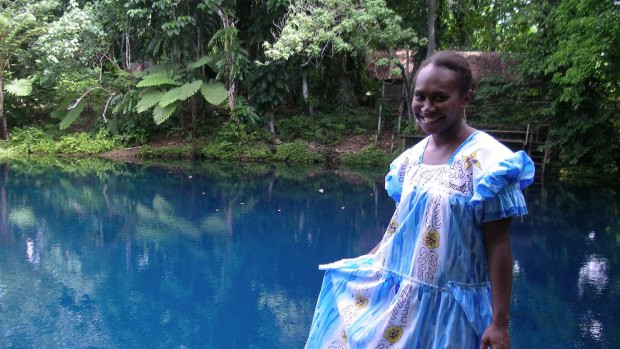
Santo Christina Karli from Oyster Island Resort.Credit: Pauline Webber
Ni-Vanuatu society is built around a network of intersecting family and community obligations and responsibilities. Most people live in villages and have close connections to the land, all of which is still in the hands of traditional owners.
The properties on which foreign investors build are on long-term leases and involve access rights for the ni-Vanuatu. It's this overt symbiotic relationship that makes tourism here so interesting. Even if all you want is to kick back in a hammock, coconut juice in hand, your experience will be better if your resort management understands and works with local community.
First impressions of Espiritu Santo, a 45-minute flight north west of Vila, are of a green heartland ringed in blue. Its handful of hotels and resorts are strung along beautiful beaches or scattered around Luganville, the island's one tiny town, built during World War II with a street wide enough to take army tanks.
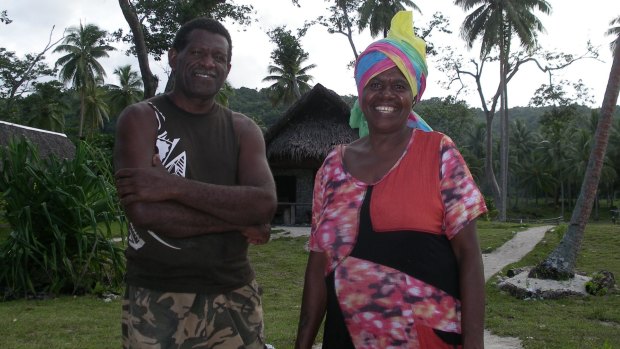
Santo Louis Tiome and his wife run Port Olry Beach BungalowsCredit: Pauline Webber
The US military had a base here and Santo is littered with fascinating wartime memorabilia and detritus. Million Dollar Point, where the Americans dumped tons of military equipment and vehicles after the war, is now one of the world's best dive locations.
And Santo is a food bowl. French colonists gave the country good coffee and patisseries along with plantations and catholicism. Ni-Van vegetable gardens and coconut plantations, where honey-coloured cattle graze in the steamy shade, dot the landscape. Vanuatu has the best beef you are ever likely to taste, all of it organic, like all the produce grown here.
Oyster Island Resort sits in a marine reserve off Santo's spectacular east coast.
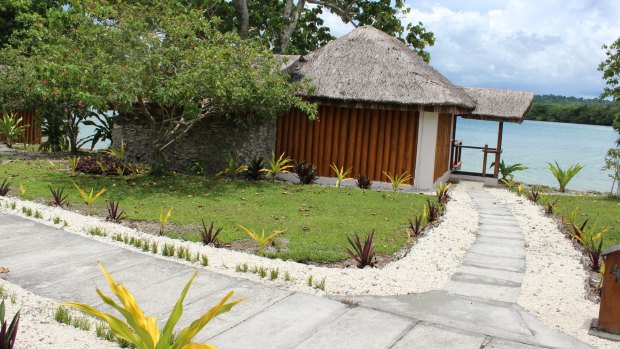
Oyster Island Resort waterfront bungalows are attractively furnished.Credit: Oyster Island Resort
"We've got a dugong with a new pup in the bay so keep an eye out for her," Oyster's Australian manager Brad Henstock tells me on the short ferry ride to the island.
He and partner Sarah Walker aim to provide a homey comfortable environment for their guests.
"While you're with us, you're part of the family," he tells me. And indeed, Oyster has a lovely relaxed feel to it. Staff are friendly and attentive without being intrusive and you can do your own thing, even if that's just lying around with a beer, and a book from one of the shelves in the nakamal.
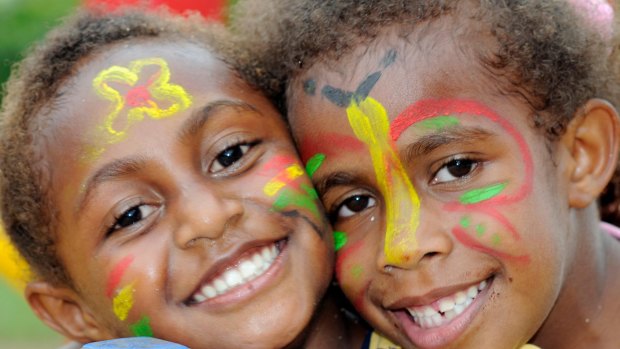
Face paint adds colour to young girls in Port Vila, Vanuatu.Credit: Alamy
My bungalow is simply and attractively furnished, a coral bathroom (with access direct to outside so you don't trail sand and water through the bedroom) and a deep over-water deck. Lying there in my hammock, I can gaze out into turquoise waters and emerald-green, bush-clad hills.
After a swim among brightly coloured fishes, I take a wander around the island and through the resort farm, which has supplied most of the food we are to eat at tonight's barbecue feast. It's peaceful and still, with just the sound of the breeze and the birdsong.
I don't see the dugong sadly but I do take a tour by outrigger canoe to Riri River Blue Hole, one of many "blue holes" in the region. The sapphire-blue colour of these pools is caused by deep underwater caves in the limestone rock; the deeper the cave, the bluer the water. We go across to Riri by car but the resort can also get you there by motorboat.
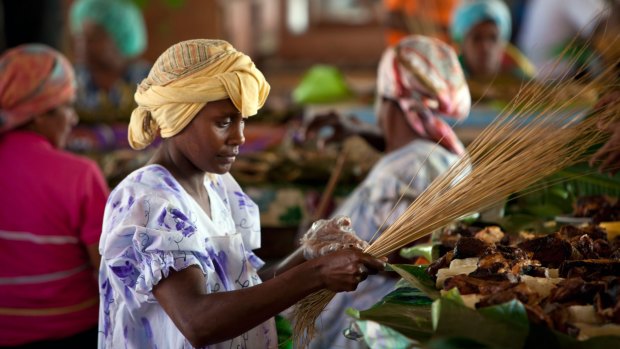
Local villagers in Port Vila, Vanuatu.Credit: Alamy
Tour manager John Bani has developed a cultural tour that includes a visit to his own village nearby, and to locally owned and managed beauty spots.
"We just want our guests to see and understand something of our life here," he says. Bani understands that close ties with community enhance the holiday experience for the visitor and benefit the resort.
"At Oyster we offer a tour to [nearby] St Barnabas School. The proceeds go straight to them. Oyster doesn't take a cut."
This kind of interaction is repeated widely across the island. Dave Cross, who's something of an expert on Santo's World War II history, has owned Beachfront Resort for more than 20 years. He has 26 ni-Van staff and participates in the UN's Women and Food program.
By supplying direct to resorts and, over time, growing produce specifically for them, local women are able to extend their income beyond what they can sell at the local market each day.
At Village de Santo, owner Bev Anti has built such strong connections with local craftspeople, artists, dancers and musicians that her small resort near Luganville is now first choice for visitors with an interest in culture and the arts.
Anti is one of the people behind an annual music festival now in its fifth year. She's passionate about island culture but her interest extends to more prosaic subjects, too. Get her started on waste management and you'll soon realise she's prepared to get her hands dirty for this island and its people. And you'll know why Santo is so much cleaner than many Pacific islands.
Villagers on Santo acknowledge the significant contribution tourism makes to their economy, but they want to have a say in how it works. Communication is key. Chiefs need to be involved in decision-making and conflict resolution.
Moyyan House by the Sea at Barrier Beach is an intimate resort of just six exquisite bungalows. Neon-bright fish dart about the coral quays that begin just a few metres offshore. The local chief is keen to establish a marine reserve here and Moyyan's owners strongly support him. They also contribute funds to the local library, kindergarten and other village institutions as well as supporting locals to develop and manage their own tours.
Kalmer Vocor, who owns Lonnoc Beach Bungalows, was one of the first ni-Vanuatu to get into tourism. He's now chairman of Sanma Province Tourism Association.
"Tourism can make a really rapid difference to the standard of living for ni-Van," he says. "That's why I started the tourism school. I think the model works for us."
Vocor's college offers a one-year course in hospitality. "Some of our graduates are now employed at Oyster," he says. "Educational qualifications are important because the government has recently introduced an accreditation system. That's going to help develop a better career path for ni-Vanuatu in the industry."
Christina Karli works at Oyster Island Resort. Her husband is head chef at nearby Lope Lope Lodge. Their three children live with Karli's mother in her home village on Malekula Island and she sees them only on her holidays.
"I miss them but I know they are secure and they're being raised in my own culture," she says. "I love my job and I'm happy to have a career. I cannot imagine now just living in my village."
Vocor is closely involved with Lonnoc, but employs two Australians to manage it. It's unusual to see this arrangement, but it may become more common as ni-Vanuatu take control of their resources and investments.
One ni-Van who has taken that control is Louis Tiome. With his wife he owns and runs Port Olry Beach Bungalows and Chez Louis Restaurant. They have a few simple bungalows and the restaurant, which is right on the beach.
"Some of our customers come from other resorts," says Tiome. "They want to experience our way of life just a little so they stay a night or two with us then return to their world."
The ni-Vanuatu are what makes the country such an attractive holiday destination. It's not just beautiful, it's full of friendly and courteous locals who genuinely want you to have a great time.
That goodwill can grow even stronger as long as ni-Van have some stake in their nation's single biggest earner. And as long as the tourists start coming back in big numbers.
TRIP NOTES
MORE INFORMATION
GETTING THERE
Air Vanuatu operates flights from Sydney and Brisbane to Port Vila six days a week, and from Brisbane to Santo once a week. It has flights daily between Port Vila and Santo. Qantas connects from Melbourne and other Australian cities: airvanuatu.com
STAYING THERE
Espiritu Santo: Oyster Island Resort and Restaurant, East Coast, has bungalows from $150 per night; oysterisland.com.
Moyyan by the Sea, Barrier Beach, offers luxury accommodation from about $320 a night, restaurant and day spa; moyyan.com.
Beachfront Resort, Luganville, has a wide range of accommodation, from backpackers to comfy bungalows, and offers a service to cruising yachts; thebeachfrontresort.com.
Village de Santo, Luganville has stylish bungalows for $140 a night; villagedesantoresort.com.
Lonnoc Beach Bungalows and Restaurant has rooms from $56 a night; lonnocbeachbungalows.com.
Port Olry beach Bungalows and Chez Louis Restaurant, from $75 a night: +678 5990320, +678 7761908.
Port Vila: Almost all smaller boutique hotels and many larger resorts have reopened. Ripples Resort was undamaged, with rooms from $175 a night; ripplesresortvanuatu.com.
Luxury resort The Havannah has reopened, with rooms from $500 a night; thehavannah.com.
SEE + DO
Dive WW II relic sites such as Million Dollar Point: allan-power-santo.com; canoe to Matavulu, Nanda and Riri River blue holes (your resort can arrange this); explore the reefs without getting wet in Cruising Safaris' glass-bottom boat: cruisingsafaris.com; St Barnabas and Custom Village tours from Oyster Island Resort.
The writer was a guest of Air Vanuatu and Oyster Island Resort.
Sign up for the Traveller Deals newsletter
Get exclusive travel deals delivered straight to your inbox. Sign up now.